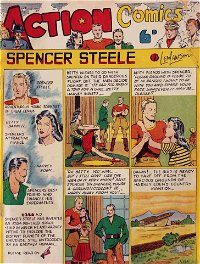H. John Edwards by James Zee
Introducing H. John Edwards
While many Australian publishers disguised the international origins of their comics, H. John Edwards reprints were branded with the logos of US companies such as Fiction House, Standard and MLJ Magazines (Archie).
He also published a large line of original Australian comics with art by some of this country's most accomplished artists, including Larry Horak, John Dixon and Jeff Wilkinson.
Henry John Edwards was born in Victoria in 1913. He worked as business manager for K. G. Murray and was involved in the creation of Man, Man Junior and Cavalcade before becoming a publisher himself,11p. 184, John Ryan's Panel by Panel... producing thousands of comics, trade magazines, paperbacks and hard cover novels.
H. John Edward's first venture was a partnership with Peter Huston to form Peter Huston Publishing in August 1944. The most significant result of that venture was the creation of Edward's flagship series, Action Comic, in October 1946.
When the partnership with Houston ended in 1947, Edwards established his own company22p. 184, John Ryan Panel by Panel. There is limited information on Peter Huston and it is unknown whether details... and retained the Action Comic series, after which he later named his company.
Over the coming decade, Edwards published under various names, including H. John Edwards, Leisure Productions,33The tone of some references to Leisure Productions suggests that H. John Edwards might have acquired Leisure Productions. The publisher... Action Comics and Popular Publications. Late in the 1950s, it seems he produced some Archie reprints as Archie Publications Pty. Ltd.—although the licence might have transferred to another company by that time.
Edwards' was also the third largest producer of pulp novels in Australia during the 1950s, behind Cleveland and Horwitz.44Katherine Bode reports Action Comics published 180 books during the 1950s, 9.4% of the novels known to be published. Katherine...
H. John Edwards benefitted from the specific publishing enviornment in Australia in the 1940s and 1950s, especially import bans due to the Second World War and continued tariffs on American publications from 1939 to 1959. The company ceased publication in 1959,55The date when the company ceased publication is uncertain. At least 1959 seems likely based on the often reported 13... likely a casualty of the end of tarrifs and the arrival of television in Australia.
The popular Action Comic helped establish Edwards' company and notched up over 130 comics over 13 years, yet it is possible that it also helped contribute to the company's demise through the infamy of its creator, Len Lawson.


